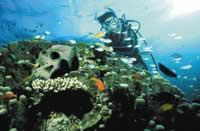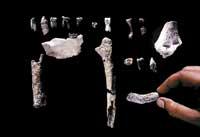Were we years?
2002/03/01 Roa Zubia, Guillermo - Elhuyar Zientzia Iturria: Elhuyar aldizkaria

Eye! What you read on these pages is not necessarily correct. It is nothing more than a hypothesis, at first somewhat surprising, but the consequence of a deep reasoning and scientific reflection. On the first occasions presented, paleoanthropologists laugh at this hypothesis and the author, but more and more interest has arisen among scientists. Phillip V. The prestigious South African anthropologist Tobias, in an article, wrote on this hypothesis: "Before the Savannah hypothesis did not leave room for any other approach, but now paleoanthropologists should try to analyze the hypothesis with an open attitude."
In general, it is assumed that chimpanzees, gorillas and humans had the same anchor. However, the first two seem more like each other than among human beings, which is not so easy to explain. Of the three species, the only one that has lost hair, has been on two legs and has increased the brain is man. According to the most widespread hypothesis, man moved to live from forests to savannah, and his conditions led him to develop these characteristics.
This hypothesis is so accepted that many times scientists forget questions that do not respond to this theory. If the characteristics of the human being are a consequence of life in the savannah, it can be expected that the tendency in other species of the savannah is the same as evolution advances. But this has not been seen and the particularities of this primate can be explained from another hypothesis. Let's see it.
Aquatic hypothesis
The oldest fossils of hominid found are those of the genus Ardipithecus and Australopithecus. Paleontologists study whether the older of the two, the Ardipithecus, was on two legs or not (it seems like yes). With the Australopithecus, however, there is no doubt that the appearance of fossil bones is significant. The chimpanzees, for their part, have been kept on four legs. Then, how did the hominids rise? All the hypotheses coincide in that the habitat of these primates changed somehow and, therefore, they too.

Most of these fossils were found in the territory of Afar, in Ethiopia, quite close to the African "horn". (All the fossils that have not been found in the territory of Afar were around lakes and large rivers). This territory is a country of delta aspect, due to the last kilometers of the Awash river basin. According to the aquatic hypothesis, about 7 million years ago the sea level rose and covered this territory, forming the Afar Sea.
The water became, in the short term, the environment of the primates. Some were "trapped" in the islands (today at the top of the Danakil Mountains) and many others in the marshes, lakes, flooded forests and newly created coastline. In one way or another, they had to adapt to the new ecosystem.
Consequently, evolution progressed and caused changes in primates. To move through the lakes they had to train on two legs. In addition, unlike chimpanzees and gorillas, hominids lost their hair and distributed body fat in another way; like marine mammals, the man has a layer of fat attached to the skin.
According to the previous data

The aquatic hypothesis was first proposed in 1923 by the German physician Max Westenhöfer. Without knowing the above, the British marine biologist Alister Hardy made the same approach in 1929 and published it thirty-one years later. Over time, however, the hypothesis of the savannah was strengthened to impose itself. However, scientists Elaine Morgan and Marc Verhaegen, based on Hardy's ideas, have developed an aquatic hypothesis in the last ten years. This hypothesis corresponds to all the fossils found so far and explains many other characteristics of hominids.
Man is the only primate that controls breathing. The rest, and most mammals, automatically breathe just like the heart beats. Controlling breathing is fundamental, among other things, to be able to speak. This feature is exclusive to the diving mammals. On the other hand, the species that can breathe through the mouth are very scarce, even in that the human being is eccentric. In fact, Darwin was very surprised by the anatomical reorganization that this characteristic required (the position of the throat and lungs is very curious about other primates). In birds only those who submerge breathe through the mouth: pelicans, ditches, penguins and others. In mammals, marine lions have this capacity.

It is also worth analyzing the processes that occur in the skin. On the one hand, the animals of the savannah do not sweat. In our case, this feature has been associated many times with the lack of hair, but these animals have developed other methods to control the interior temperature without losing hair. On the other hand, all the animals that cry (that is, that tears escape from the eyes) are marine. The sebaceous glands also separate us from other primates. In chimpanzees, for example, these glands are very small and scarce, while in humans they intervene in the functioning of the skin and have to do with serious problems such as acne of adolescence. The presence of sebum in the skin may indicate contact with water, since sebum facilitates this contact.
Origin of intelligence
In the difference between man and the other primates predominates the size and complexity of the brain. For the development of the large brain nutrients such as phosphorus, iodine, copper, iron, long chain unsaturated acids, etc. These nutrients abound in marine and coastal foods.
In fact, the disease associated with the shortage of iodine, goiter, is more abundant in terrestrial populations than in coastal populations. As for phosphorus, it is mainly extracted from fish and shellfish, data that allow to conclude that the brain of the hominids was developed thanks to a diet based on seafood products.

To say that man evolved by the sea seems a sensible and coherent hypothesis. Verhaegen believes that the fossils of Homo erectus and Homo sapiens neanderthalensis have appropriate characteristics for diving. Homo erectus fossils have been found on some islands in Indonesia and, even at the lowest level of the sea, they had to cross the foothills. We cannot know if at that time navigation was known or not, it is a question long discussed, but there is no doubt that they exceeded 19 kilometers of sea. Estegodona, a type of archaic elephant, also swam to the island.
In the Strait of Gibraltar there was a similar situation. The sea level had dropped a lot during the glaciation, but, however, it had to cross 5 kilometers of coast to go from Africa to Europe (or vice versa). Did the Neanderthal man ever travel? The debate will not be diluted for the moment, since few deposits in North Africa have been excavated, but the paleontologists do not rule out this possibility, since some of them have found tools of the Moustier era (type of instruments that we join the Neanderthal Man).
Open debate open debate
According to the aquatic hypothesis, man expanded in the world following the coast and rivers, because he has never totally lost dependence on water. In fact, it is not difficult to explain this last idea through other hypotheses. Other points are debatable and it is considered very enriching to present arguments against the hypothesis.

However, the Savannah hypothesis is widely accepted among scientists, so the study of human evolution from another point of view is not often well considered. Elaine Morgan complains about this attitude. The aquatic hypothesis, if it should be discarded, should be discarded by scientific arguments and not without proper analysis, according to him.
The American anthropologist John Langdon is very skeptical of the aquatic hypothesis, but he explains the reasons for the scientific debate. One of Langdon’s basic criticisms is that the aquatic hypothesis tries to explain a complex evolutionary process from a single idea, saying it is a “umbrella hypothesis”. The umbrella hypotheses communicate easily and this usually has a great success, but this does not ensure correction. In the case of human evolution, fossils have indications of a progressive adaptation, so the changes produced at a given time cannot explain all their characteristics, although this moment is at a geological scale.
As for the conversion of Hankabi, Langdon states that this characteristic has not gone from walking on four legs and has evolved; he considers that the hominids lived in the trees, so they were changing little by little when walking on horns. Therefore, there is no need for aquatic means to explain that the Australopithecus became patiotic.

Our limbs are suitable for swimming, but this adaptation occurred millions of years after the appearance of the genus Homo, a supposed aquatic time. Understand controlled breathing as a consequence of amalgam, changing locomotion mode by the need to develop a 'free' breathing.
On the other hand, Langdon believes that hair loss is not explained by the action of water, if man had become a complete marine mammal, but then the current situation would be another. But the aquatic hypothesis does not go so far, supposedly to reach the current situation, hominiids would be only semi-aquatic animals. In addition, the fat layer does not cover the entire human body. In short, Langdon considers that the characteristics of the skin are consequence of the adaptation to human activities, activity that requires a strict thermal control.
Paleoanthropology is a science based on few fossils and the most accepted theories are also based on assumptions. For this reason, archaeologist Tobias is in favour of improving the aquatic hypothesis; many of the arguments he proposes are debatable and, however, he has a very interesting idea. The debate is open and interesting.


Gai honi buruzko eduki gehiago
Elhuyarrek garatutako teknologia






